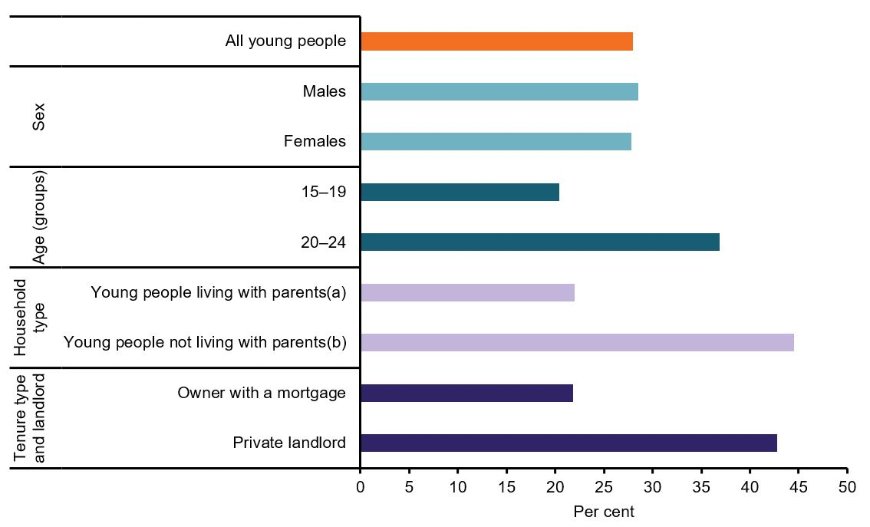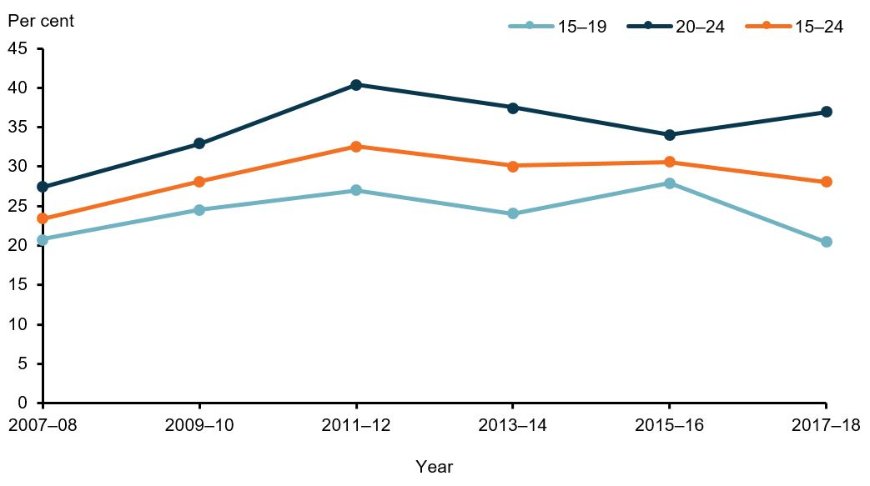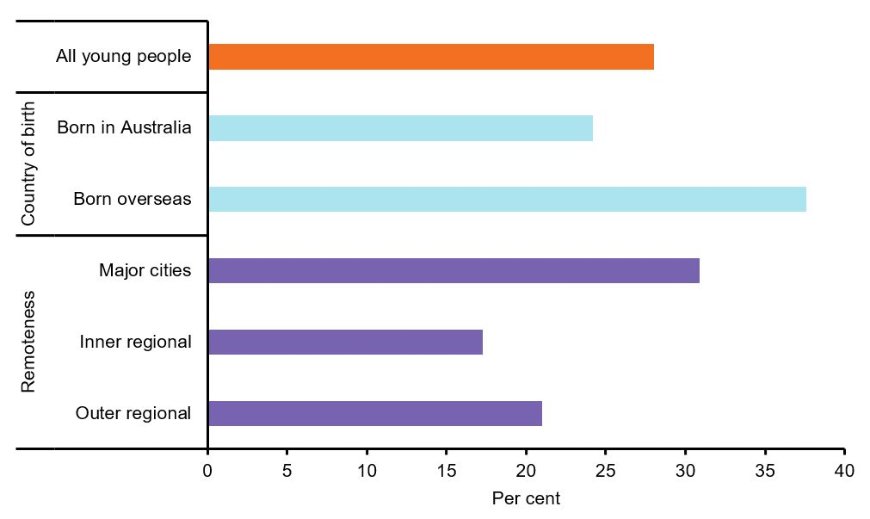Key findings
- In 2017–18, 28% (around 299,900) of young people aged 15–24 lived in lower income households experiencing housing stress.
- The proportion was higher among those aged 20–24 (37%) than among those aged 15–19 (20%).
- The proportion was higher among those living in Major cities (31%) than among those in Inner regional areas (17%).
Affordable housing is a key dimension of economic wellbeing. Housing costs, such as rent payments or mortgages, are often the largest regular expense in a household budget. Spending a high proportion of disposable income on housing costs reduces what households can afford to consume and save to support other aspects of their wellbeing (OECD 2020).
High housing costs make low-income households particularly vulnerable as this can limit spending on other basic essentials, such as food, health care and education (OECD 2020).
Living in unaffordable housing can also be stressful and can be detrimental to mental health among those in households in the bottom 40% of income distribution (Bentley et al. 2011) (see Box 1 for a definition of lower income households).
A key aspect of the transition to adulthood is to live independently. However, difficulties securing affordable housing can delay a young person’s decision to move out of the parental home.
- Data from the ABS Survey of Income and Housing shows an increase in the number of young people living with parents between 2007–08 and 2017–18 (see Demographics of Australian young people and their families). It is likely that there are young people who would prefer to live independently, but chose to continue to stay with their parents, or to live in group housing, to avoid living in housing stress.
Housing stress as defined here, does not capture those who may choose to spend a greater proportion of their income on housing in order to be closer to education and/or employment opportunities, thereby offsetting other costs (for example, transport costs).
Box 1: Data sources and definitions
Data on housing stress are from the ABS Survey of Income and Housing (SIH). The SIH is a household survey that collects information on sources of income, amounts received, household net worth, housing, household characteristics and personal characteristics (ABS 2019b). It is based on a sample of 14,060 households.
In this section, housing stress is defined as occurring when a lower income household is spending more than 30% of its gross household income on housing costs. For more information, see ‘Housing stress’ in the Explanatory notes of the Australian Bureau of Statistics (ABS) publication Housing occupancy and costs.
Lower income households
Lower income households are defined as those in the lowest and second equivalised disposable household income quintiles, excluding the first and second percentiles (that is, the third to the 40th percentiles inclusive). The first and second percentiles are excluded due to the high wealth and expenditure characteristics that some of these households exhibit, and the prevalence of income types other than employee income and government pensions and allowances (ABS 2019b).
This definition is based on that used in the ABS publication Housing occupancy and costs. For more information see ‘Lower income’ in the glossary of the Survey of Income and Housing, user guide.
How many young people live in lower income households experiencing housing stress?
In 2017–18, based on the ABS Survey of Income and Housing, among young people aged 15–24 living in lower income households, around 28% (an estimated 299,900) were in households experiencing housing stress.
The proportion of young people living in households experiencing housing stress was:
- higher among those aged 20–24 than among those aged 15–19 (37% compared with 20%)
- higher among those not living with parents compared with those who did (45% compared with 22%) (see Box 1 for definitions). It should be noted that the proportion of those not living with parents has a high margin of error (11)
- higher among renters than owners (with or without a mortgage) (40% compared with 16%)
- higher among those who were private renters than owners with a mortgage (43% compared with 22%) (Figure 1).

(a) Young people living with parents are either dependent students aged 15–24, or non-dependent children aged 15–24.
(b) Young people not living with parents are all young people aged 15–24, excluding those who live with their parents as dependent students aged 15–24, or non-dependent children aged 15–24. Value has a high margin of error (11) and should be used with caution.
Chart: AIHW.
Source: ABS 2019a.
Have rates of housing stress changed over time?
Between 2007–08 and 2017–18, the proportion of young people aged 15–24 living in lower income households and experiencing household stress fluctuated. The proportion increased between 2007–08 and 2011–12, from 23% to 33%. However, the proportions in 2011–12 and 2017–18 were similar (33% and 28%, respectively) (Figure 2).
Patterns of changes over time differed by age group. For 15–19 year olds, the rate dropped between 2015–16 and 2017–18, from 28% to 20%. For 20–24 year olds, the proportion increased between 2007–08 and 2011–12, from 27% to 40%. However, the proportions for 2011–12 and 2017–18 were similar (40% and 37%, respectively).

Chart: AIHW.
Source: ABS Survey of Income and Housing 2017–18.
Are rates of housing stress the same for everyone?
In 2017–18, among young people aged 15–24, the proportion of those living in households experiencing housing stress was:
- higher among those born overseas than among those born in Australia (38% compared with 24%). It should be noted that the proportion of those born overseas has a relatively high margin of error (10%).
- higher among those living in Major cities (31%) than among those living in Inner regional areas (17%) (Figure 3).

Note: The data for young people born overseas have a high margin of error (10%) and should be used with caution.
Chart: Australian Institute of Health and Welfare (AIHW).
Source: ABS Survey of Income and Housing 2017–18.
Where do I find more information?
For information on topics related to housing stress in Australia’s youth, see:
For information on Indigenous young people and housing circumstances, see:
For information on children (aged 0–14) and rental stress, see Housing stress in Australia’s children.
For more information on access to affordable housing across the Australia population, see:


